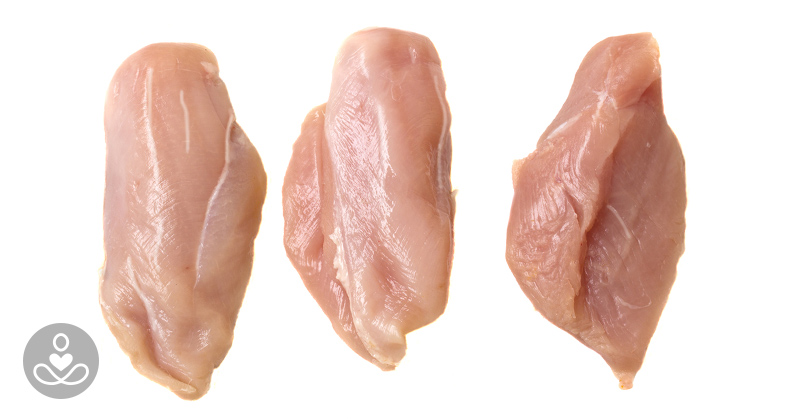“You are what you eat, and you are what you eat eats.” This is a quote from Michael Pollan in his book In Defense of Food: An Eater’s Manifesto. In the case of poultry in Europe and North America, nothing could be more poignant.
What are those white stripes on chicken breasts?
There is a massive demand for chicken breast in both Europe and North America, due to its lower cost than most pork or beef, ease of preparation, availability of convenience products, lack of religious constraints, and especially for its perceived health benefits. The pressure to produce a larger number of bigger birds has resulted in poultry marketed in half the time and at two times the body weight that it was 50 years ago. With demand primarily for breast meat, birds have been bred to have pectoral muscles that are now 20% of their body weight. (1)
A study from The Italian Journal of Animal Science reports an increasing issue of what’s called ‘white striping’ in conventionally-grown chicken breasts. This is a defect in which white striations appear parallel to the muscle fibers, and result in a drastic change in the nutritional quality of the meat. The breast is now higher in fat by up to 224%, but much lower in protein. What’s worse, is that this difference in nutritional properties may or may not appear on the label. (1) (2)
The exact cause of this poultry epidemic is not known, it is likely a result of the intense genetic selection towards increased growth rate and breast size of conventional chickens, coupled with the conditions in which they are raised and the diets that they are fed. (1) (2)
The Problems with Conventional Poultry
Living Conditions
Conventionally raised birds are kept in cages their entire lives, packed so tightly with thousands of other chickens that they can’t even open their wings. The are made to grow fast and disproportionately so that they are unable to support their body weight and end up lying in their own feces. (3) (4)
Hormones
Not only are they often fed soy-based products which increase estrogen levels, but the stress that each bird experiences due to their living conditions and fear experienced during slaughter increases the amounts of stress levels in their bodies. These steroid hormones – such as adrenaline and cortisol – end up in our meat. (3)
Antibiotics
The use of antibiotics to attempt to lower rates of bacteria and illness in poultry ends up creating antibiotic-resistant bacteria, which also ends up in our food. In their Antibiotic-Resistance Threat Report, the CDC found that 2 million Americans are infected by these bacteria each year, and at least 23,000 die as a result. (3) That’s why it’s so important to only eat meats that are antibiotic-free (plus grass-fed and organic is even better!). Our friends at Butcher Box can deliver high quality meat to your door at an affordable price- it works out to be just $6 a meal!
Low-Quality Feed
Their diets are often high fat and full of pesticides, herbicides, fungicides, and of little nutritional value. This again translates into a poor nutrition quality of our meat. (3)
Ammonia and Bad Bacteria
The levels of ammonia the chickens are exposed to have a negative impact on the chicken’s weight, growth rate, and health. Ammonia exposure comes from living in cramped, poorly-ventilated conditions with no opportunity to roam outside. (3) (5) (6)
Choose Non-Conventional Chicken
If you are at all concerned about your health and the health of the planet, choosing organic, pastured or free-range chicken is the way to go. Buying meat with these standards ensures nutritional quality, better flavor, and humane practices. (8) You are also protecting yourself and your family from the hormones, antibiotics, and other toxins that come from conventionally-raised chicken.
Your best option is to buy from your local farmer or farmer’s market. Visiting the farms and meeting the people who are raising your food ensures best practices and supports the local and sustainable economy.
Understanding Food Labels
If you don’t have access to a farm or farmer’s market, you can still buy quality products in the grocery store. To make the most health-conscious, animal welfare-conscious, and environmentally-conscious decision, it’s important to understand what each label means.
- Organic (Canada & US): Hens are fed organic feed, do not receive any antibiotics or vaccines, and have nest boxes with access to the outdoors. (3)
- Pasture-Raised: Chickens are kept outside year-round with optional housing during inclement weather and protection from predators. They are free to eat whatever they choose, along with any feed the farmer may provide. (7)
- Free-Range: The USDA defines this as “access to the outdoors”, with no requirements on how much access that is. (3) (7)
- Cage-Free: Not raised in cages but likely indoors, no stipulations for their feed. (3)
Choosing to buy local, organic, and humanely raised poultry is the only way to ensure the health of you, your family, and the planet.
Sources
- https://www.tandfonline.com/doi/full/10.4081/ijas.2014.3138
- https://academic.oup.com/ps/article/92/2/331/1537846/Pathological-changes-associated-with-white
- https://www.centerforfoodsafety.org/files/animal-welfare-final_56276.pdf
- https://elibrary.asabe.org/abstract.asp?aid=22042&t=2&redir=&redirType=
- https://academic.oup.com/ps/article-abstract/59/3/486/1565005/Ammonia-in-the-Atmosphere-during-Brooding-Affects
- https://certifiedhumane.org/free-range-and-pasture-raised-officially-defined-by-hfac-for-certified-humane-label/
- https://academic.oup.com/ps/article/87/1/71/1567067/Pasture-Intake-Improves-the-Performance-and-Meat

